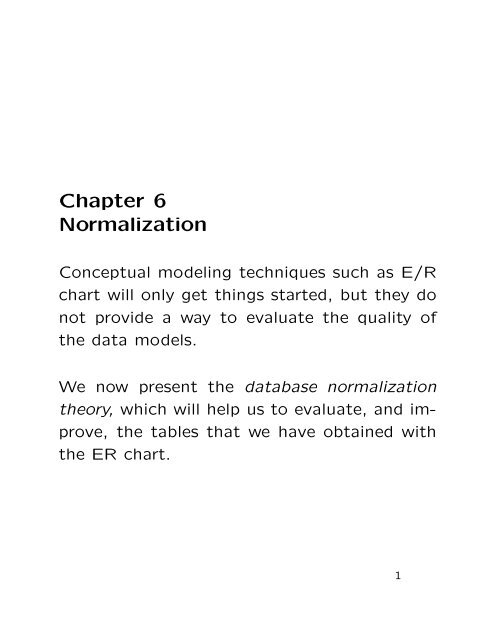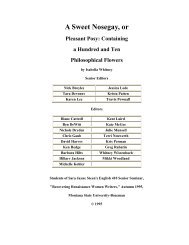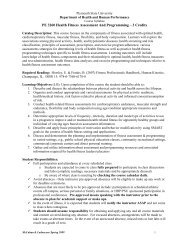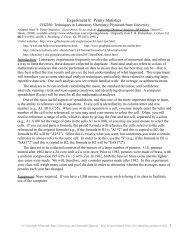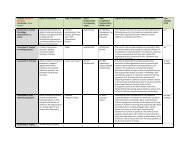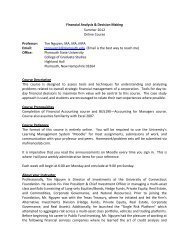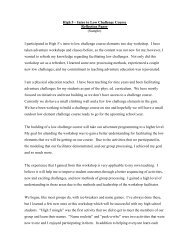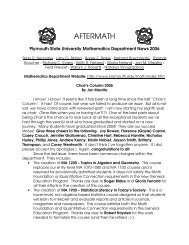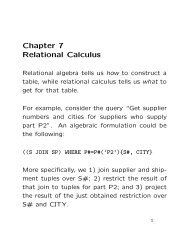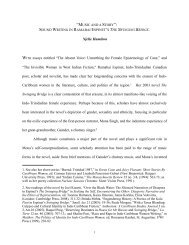Chapter 6 Normalization
Chapter 6 Normalization
Chapter 6 Normalization
Create successful ePaper yourself
Turn your PDF publications into a flip-book with our unique Google optimized e-Paper software.
<strong>Chapter</strong> 6<br />
<strong>Normalization</strong><br />
Conceptual modeling techniques such as E/R<br />
chart will only get things started, but they do<br />
not provide a way to evaluate the quality of<br />
the data models.<br />
We now present the database normalization<br />
theory, which will help us to evaluate, and improve,<br />
the tables that we have obtained with<br />
the ER chart.<br />
1
The basic approach<br />
The main tool we will use is the functional<br />
dependency, which generalizes the key dependency<br />
concept that we used in E/R modeling.<br />
Functional dependency will help us to spot unnatural<br />
situation where attributes of unrelated<br />
relations are placed in one relation. The gist is<br />
still what you learned in Java: One class talks<br />
about one thing only.<br />
We can then break apart such a complicated<br />
relation into a bunch of smaller and/or simpler<br />
relations which leads to a more normalized,<br />
i.e., natural , database.<br />
2
Remember this one<br />
Consider the following Person table, which is<br />
obtained via a direct translation from an E/R<br />
diagram.<br />
Create Table Person (<br />
SSN Integer,<br />
Name Char(20),<br />
Address Char(50),<br />
Hobby Char(10),<br />
Primary key (SSN, Hobby))<br />
We notice that SSN itself is not a key, a combination<br />
of SSN and Hobby is, since the latter<br />
potentially could have a multiset as its value.<br />
3
What’s wrong with it<br />
Given the following table<br />
ID Name Address Hobby<br />
1111 John Doe 123 Main St. Stamps<br />
1111 John Doe 123 Main St. Coins<br />
2222 Mary Doe 7 Lake Dr. Acting<br />
If John Doe moves to 1 Russell Street, we have<br />
to change the address information in both tuples<br />
for John. Imagine what happens if John<br />
has 123 hobbies.<br />
We either have to update this information 123<br />
times, and if we miss even one, the information<br />
will no longer consistent.(Update abnormally)<br />
A reason for this abnormally is that the address<br />
information is redundantly kept: we have to<br />
repeat it for every combination of key value.<br />
4
Another abnormally<br />
Assume that we want to add Homer Simpson<br />
into the table, but he does not have any hobby<br />
yet. One way to do it is to place null into the<br />
hobby field for him, but since Hobby is part of<br />
a primary key, we can’t do that. (Insertion<br />
abnormally)<br />
This table mixes up two things: where you live,<br />
which depends only on your SSN; and what you<br />
like to do, also should only depend on your<br />
SSN.<br />
When we mix them up, because Hobby is multivalued,<br />
we have to put it into the key, which<br />
causes this much trouble.<br />
5
Yet one more<br />
Just assume we can get away with that. Later<br />
on, Homer develops a hobby, say acting, when<br />
we add in this row, should the original one with<br />
null be replaced We might think so, but the<br />
computer has no reason to take it out.<br />
Assume that we can also get away with this issue,<br />
when Home no longer likes acting, and we<br />
delete this row. We not only delete the acting<br />
part, but also all the other information, such<br />
as his address, since Hobby is part of the key.<br />
Thus, we should only replace acting with NULL.<br />
But, this can’t be done.(Deletion abnormally)<br />
Question: Can you figure out what is going<br />
on and why yourself<br />
Answer: We keep too much information in<br />
one table.<br />
6
Decomposition<br />
The solution to the above problem is easy: We<br />
decompose the original table into two smaller<br />
ones:<br />
Person(SSN, Name, Address)<br />
Hobby(SSN, Hobby)<br />
It is easy to see that the original relation is just<br />
the join of the two derived relations. Thus,<br />
we say that this decomposition is lossless. In<br />
other words, we don’t lose any information by<br />
carrying out such a decomposition.<br />
As a result, Hobby, which might be missing, is<br />
no longer part of a key; while SSN, which is<br />
never missing, is the key of the first relation.<br />
For the second relation, the key consists of<br />
both attributes (). If you don’t have a hobby,<br />
you are not in....<br />
7
What would it look like<br />
Below shows an instance of this revised schema.<br />
Question: How far could we go<br />
Below shows an ultimate, but useless, decomposition.<br />
Notice that they are no longer related.<br />
8
What have we learned<br />
1. Decomposition can serve as a useful tool<br />
that augments conceptual modeling by cutting<br />
out some of the redundancy.<br />
2. The criteria of choosing the right decomposition<br />
is not straightforward, especially when<br />
we have to deal with a complicated relation,<br />
which is where such guidance is needed the<br />
most.<br />
Thus, we will develop various techniques in this<br />
part, based on the idea of functional dependency,<br />
that will guide us through to develop<br />
various normal forms.<br />
9
Functional dependency<br />
We use upper cases of the beginning letters,<br />
such as A,B, C, ..., to represent individual attribute,<br />
and use upper cases of the letters near<br />
the end of the alphabet with bars over them,<br />
such as P, V , Z,... to represent a set of attributes.<br />
We also use, e.g., ABCD to represent set of<br />
attributes {A, B, C, D}; and use, e.g., XY Z to<br />
represent the union of these sets, i.e., X ∪Y ∪Z.<br />
10
Technically, ...<br />
..., a functional dependency (FD) on a relation<br />
schema R is a constraint of the form X → Y ,<br />
where both X and Y are attributes of R.<br />
We say that r, an instance of R, satisfies this<br />
dependency if and only if, for every pair of tuples<br />
t and s in r, if they agree on all attributes<br />
in X, then they also agree on Y .<br />
Intuitively, given an FD, X → Y , to satisfy this<br />
FD, for any two rows in a table, r 1 , r 2 , if they<br />
have the same values in X, they must have the<br />
same value in Y .<br />
This is where the word function comes from:<br />
Same input leads to the same output. Again,<br />
the same stuff as you learned in Java.<br />
Homework: 6.8.<br />
11
A bit review<br />
The essential requirement imposed by an FD<br />
is an implication, A → B. Conceptually, implication<br />
comes with the following truth table.<br />
A B A → B<br />
F F T<br />
F T T<br />
T F F<br />
T T T<br />
Thus, the only case an implication fails is when<br />
A holds, while B does not. In other words, if A<br />
holds, then to ensure the implication constraint<br />
holds, B must hold.<br />
For example, when I say “If I have $5, the lunch<br />
is on me.” the only case you can say I lie is<br />
when I do have $5, but don’t buy you lunch.<br />
12
FD examples<br />
Given the following value of a table SCP, telling<br />
us some suppliers with a home base supply a<br />
certain number of parts.<br />
S# CITY P# QTY<br />
S1 London P1 100<br />
S1 London P2 100<br />
S2 Paris P1 200<br />
S2 Paris P2 200<br />
S3 Paris P2 300<br />
S4 London P2 400<br />
S4 London P4 400<br />
S4 London P5 400<br />
13
There are some natural relationships between<br />
the attributes. For example, it seems that every<br />
S# lives in exactly one city. Thus, {S# } →<br />
{CITY}.<br />
Moreover, this instance of SCP also satisfies<br />
several other FDs:<br />
1. {S#,P# } → {QTY}<br />
2. {S#,P# } → {CITY}<br />
3. {S#,P# } → {CITY, QTY}<br />
4. {S#,P# } → {S#}<br />
5. {S#,P# } → {S#,P#,CITY,QTY}<br />
6. {S# } → {QTY}<br />
7. {QTY } → {S#}<br />
The left- and right-hand sides of an FD are<br />
sometimes called the determinant and the dependent,<br />
respectively. When such a set consists<br />
of just one attribute, we often drop the<br />
set braces. E.g., S# → CITY.<br />
14
What do we really want<br />
We notice that QTY → CITY holds for the above<br />
instance, but it does not have to for another<br />
one.<br />
What we are really interested is the general<br />
case: A set of FDs not only hold for some<br />
instance of a table, but for all the possible instances<br />
that table could have.<br />
For example, S# → CITY holds for all possible<br />
values of SCP, since at any given time, a given<br />
supplier has to stay in just one place. Thus,<br />
any two tuples appearing in SCP at the same<br />
time with the same supplier number must necessarily<br />
have the same city as well.<br />
From now on, by FD, we mean this more demanding,<br />
time-independent sense. Below are<br />
some examples:<br />
{S#,P# } → {QTY}<br />
{S#} → {CITY}<br />
15
The nature of FD<br />
A functional dependency defined on a relational<br />
schema is really an integrity constraint<br />
imposed on all its instances, in the sense that<br />
all the instances of that schema have to satisfy<br />
such a dependency.<br />
Given a schema R = (R, C), where R is the<br />
attributes, and C is a collection of FDs, then<br />
a legal instance of R is a relation (table) with<br />
the attributes R that satisfies every FD in C.<br />
16
Key is a special FD<br />
Note that the key constraint is a special case of<br />
the functional dependency: Everything agrees<br />
on the key attribute must agree on the other<br />
stuff by definition.<br />
A bit more formally, if key(K) is a key constraint<br />
of R and r is an instance with R. By<br />
definition, r satisfies key(K) if and only if there<br />
are no pair of distinct tuples t, s ∈ r, such that<br />
they agree on K, but disagree on something<br />
else. In other words, if they agree on K they<br />
have to agree on everything else.<br />
Thus, we can represent this property of K as<br />
follows:<br />
K → A,<br />
where A is any collection of attributes of R.<br />
Homework: 6.3, 6.4, 6.6.<br />
17
Free Turkey<br />
In some cases, one FD necessarily implies, or<br />
entails, another. Thus if we guarantee the<br />
first, the second will be there for free.<br />
For example, FD {S#,P# } → {CITY, QTY} implies<br />
the following two FDs: {S#,P# } → CITY<br />
and {S#,P# } → QTY.()<br />
We obviously want to deal with as few FD’s as<br />
possible. Some of them are just trivial in the<br />
sense they always hold. For example, {S#,P#<br />
} → {S#} always holds() In general, an FD<br />
is trivial if and only if the right-hand side is a<br />
subset of the left-hand side.<br />
In practice, we are only interested in those nontrivial<br />
ones, since they correspond to “genuine”<br />
integrity constraints.<br />
18
Identify the FDs...<br />
Consider the table Person<br />
Create Table Person (<br />
SSN Integer,<br />
Name Char(20),<br />
Address Char(50),<br />
Hobby Char(10),<br />
Primary key (SSN, Hobby))<br />
Besides the assumed key dependency: SSN,<br />
Hobby → SSN, Name, Address, Hobby, it could<br />
have other dependencies among its attributes.<br />
For example, each person has at most one address<br />
and a name, i.e., SSN → Name, Address.<br />
Also, each person has some hobbies, which has<br />
nothing to do with where she lives, thus,<br />
SSN → Hobby.<br />
19
...and decompose the table<br />
Once we have identified such FD’s, we can<br />
decompose the table by projecting it with the<br />
FD’s.<br />
For example, given the Person table with the<br />
following FDs:<br />
SSN → Name, Address and SSN → Hobby;<br />
we can decompose the Person table via a projection<br />
of the original table to the attributes<br />
as associated to the FDs, which leads to the<br />
following two smaller tables:<br />
Person(SSN, Name, Address)<br />
Hobby(SSN, Hobby)<br />
Those two tables are lossless decomposition of<br />
the original one, and moreover, they contain no<br />
redundancy. We will see why a bit later.<br />
20
The bad guy<br />
Consider the following HasAccount table,<br />
Create Table HasAccount (<br />
AccountNumber Integer Not Null,<br />
ClientId Char(20),<br />
OfficeId Integer,<br />
Primary key (ClientId, OfficeId),<br />
Foreign key (OfficeId) references Office<br />
)<br />
Every account can be assigned to only one office,<br />
thus<br />
AccountNumber → OfficeId<br />
Since a client can have a few accounts, thus,<br />
ClientId is not a key by itself.<br />
Moreover, multiple clients might jointly share<br />
the same account, leading to the same office,<br />
via the above FD. Thus, OfficeId itself is not<br />
a key, either.<br />
21
A headache<br />
This table has a key consisting of two attributes:<br />
ClientId, OfficeId → AccountNumber.<br />
AcctNumber ClientId OfficeId<br />
A057 1111 BS32<br />
A908 1234 MN08<br />
B123 1111 SB01<br />
B123 2222 SB01<br />
B321 3333 SB01<br />
Assume we have to change the office affiliation<br />
of an account, e.g., B123, since we have a joint<br />
key, we can expect that multiple rows with the<br />
same OfficeId, SB01 in this case, but different<br />
ClientId, 1111 and 2222.<br />
Question: What happens if an account is jointly<br />
owned by 155 people<br />
22
What is happening<br />
As a result, we have to locate all the rows<br />
showing different owners of this account, and<br />
change the associated office ID.<br />
In this case, we have two FDs, where a dependency<br />
of one FD<br />
AccountNumber → OfficeId,<br />
whose determinant, AccountNumber, is also a<br />
dependent of in another FD associated with<br />
the same table:<br />
ClientId, OfficeId → AccountNumber,<br />
Question: What would happen<br />
Answer: Redundancy.<br />
23
Normal forms<br />
To eliminate redundancy and potential update<br />
related issues, we have identified several normal<br />
forms for relational schemas such that if a<br />
schema is in one of these forms, it has certain<br />
predictable properties.<br />
The first normal form(1NF) is equivalent to<br />
the definition of the relational data model saying<br />
that the value of an attribute must be<br />
atomic.<br />
The second normal form(2NF) sates that a<br />
schema must not have an FD X → Y such<br />
that X is a strict subset of the key of that<br />
schema.<br />
The third normal form(3NF) is thought to be<br />
ultimate one, but Boyce and Codd came up<br />
with the BCNF to cut away more redundancy.<br />
24
What does that mean<br />
Every RDB is in 1NF. The rest is up in the<br />
air. For example, given the table Person(SSN,<br />
Name, Address, Hobby), it is not in 2NF, since<br />
it has an FD, SSN → Hobby, where SSN is part<br />
of its key: {SSN, Hobby}.<br />
On the other hand, once we split it into two<br />
tables, with SSN being the key,<br />
Person(SSN, Name, Address)<br />
with FD SSN → Name, Address, and<br />
Hobby(SSN, Hobby)<br />
with empty FD, then they both belong to the<br />
2NF, indeed 3NF and BCNF.<br />
25
One step at a time<br />
BCNF is more desirable, but not always achievable<br />
without paying a price. More normal forms<br />
have been defined such as fourth normal form<br />
and fifth normal form, which further cut down<br />
more redundancy. They essentially put more<br />
and more restrictions over the previous layers.<br />
The following picture shows their relationship:<br />
26
The BCNF<br />
A relation schema S = (R, F) is in a Boyce-<br />
Codd normal form if for every FD X → Y ∈ F,<br />
either of the following is true 1) Y ⊆ X; or X<br />
is a superkey of R.<br />
In other words, the only nontrivial FDs are<br />
those in which a key functionally determines<br />
one or more attributes.<br />
The schema (Person1(SSN, Name, Address), SSN<br />
→ Name, Address) is in BCNF since SSN, the<br />
left-hand side in the only FD is indeed a superkey<br />
for that table. The schema (Hobby(SSN,<br />
Hobby), ∅) is also in BCNF, since there is nothing<br />
to check out.<br />
If we consider the original table Person(SSN,<br />
Name, Address, Hobby), then one of the FDs<br />
SSN → Name, Address violates the BCNF condition,<br />
since SSN is not a superkey of this schema.<br />
27
A couple of points<br />
1. A BCNF can have more than one candidate<br />
keys. For example, R = (ABCD, F), where<br />
F = {AB → CD, AC → BD}, has two keys, AB<br />
and AC. R is still in BCNF, since the determinant<br />
of both FDs are superkeys, although they<br />
are different.<br />
2. Redundancy arises when the values of some<br />
attribute(s) X necessarily implies the values of<br />
other attribute(s) A, because of a FD X → A.<br />
For example, since SSN → Name, the information<br />
on Name is redundant in the following<br />
structure.<br />
SSN Name Address Hobby<br />
1111 John Doe 123 Main St. Stamps<br />
1111 John Doe 123 Main St. Coins<br />
2222 Mary Doe 7 Lake Dr. Acting<br />
28
BCNF states that if this is the case, then X<br />
has to be a key, which requires for each value<br />
of X, only one value of A will be kept. In other<br />
words, if X is a key, then there can’t be two<br />
tuples with the same value for X but different<br />
values for the others.<br />
This requirement eliminates redundancy.<br />
For example, in a decomposed table, we will<br />
have only one copy of the address for each<br />
distinct value of SSN, since the latter is the<br />
key.<br />
SSN Name Address<br />
1111 John Doe 123 Main St.<br />
2222 Mary Doe 7 Lake Dr.<br />
29
3. Duplicated data does not always mean redundancy.<br />
Given the following value of the<br />
aforementioned table R and<br />
A B C D<br />
1 1 3 4<br />
2 1 3 4<br />
It seems that it contains redundancy since the<br />
two tuples only differs on A.<br />
But, since there is no FD over the attribute set<br />
of B, C and D, there can’t be any redundancy<br />
from a technical perspective. It would contain<br />
redundancy if {A, B} is a key, and B → C,D is<br />
a FD.<br />
Thus, redundancy depends on both factors of<br />
a schema: data and the associated FD set.<br />
30
4. A relation instance that is in a BCNF schema<br />
does not store redundant information. As a<br />
result, deletion and update abnormalies won’t<br />
happen in BCNF tables.<br />
Update abnormally happens when we have redundant<br />
information about certain relationship<br />
as expressed by an FD, X → Y, where for the<br />
same value of X, multiple values of Y occur.<br />
This won’t happen in BCNF tables since for<br />
any such FD, X must be a super key, thus occurring<br />
only once in the whole table, together<br />
with any related data.<br />
31
Deletion abnormally happens in a table when<br />
in an FD X → Y, X is part of the key. Thus,<br />
when the other part of the key is deleted, so<br />
is X and all the associated data.<br />
This wont happen in BCNF tables either, since<br />
if there is such an FD, X is the key.<br />
For example, in the following table, if we delete<br />
the hobby of Mary, the whole tuple has to be<br />
deleted, since Hobby is part of its key.<br />
ID Name Address Hobby<br />
1111 John Doe 123 Main St. Stamps<br />
1111 John Doe 123 Main St. Coins<br />
2222 Mary Doe 7 Lake Dr. Acting<br />
With a BCNF tables, it won’t be an issue. If<br />
we delete, e.g., ID, the whole tuple is gone.<br />
ID Name Address<br />
1111 John Doe 123 Main St.<br />
2222 Mary Doe 7 Lake Dr.<br />
32
5. BCNF relations with more than one keys<br />
still can have insertion problems. For example,<br />
in the following instance of R = (ABCD, F),<br />
where F = {AB → CD, AC → BD},<br />
A B C D<br />
1 1 3 4<br />
2 1 3 4<br />
3 4 Null 5<br />
3 Null 2 5<br />
where we add in two nulls since we don’t know<br />
their real values at the time of entry, what<br />
happens if the C value of the third becomes 5,<br />
while the B value of the fourth becomes 4<br />
In practice, such a situation will not happen<br />
since we will designate one of them as the primary<br />
key, which can’t have a null value.<br />
33
Third normal form<br />
A relation schema S = (R, F) is in the third<br />
normal form if it is in 2NF and, for every FD<br />
X → Y ∈ F, either of the following is true<br />
1) Y ⊆ X; or X is a superkey of R; 2)each attribute<br />
in A ∈ Y −X belongs to some candidate<br />
key K of R.<br />
It is clear that BCNF is a special case of 3NF.<br />
Thus, every schema in BCNF is automatically<br />
in 3NF, while the other direction does not need<br />
to be true.<br />
The schema HasAccount(AccountNumber, ClientID,<br />
OfficeID), with its primary key being {ClientID,<br />
OfficeID}, and the FD AccountNumber → OfficeID<br />
is not in BCNF, since AccountNumber is not a<br />
superkey.<br />
However, since OfficeID is part of the key, this<br />
schema is in 3NF.<br />
Homework: 6.2<br />
34
3NF could be redundant<br />
We saw earlier that HasAccount could contain<br />
redundant information. Now, it is clear that<br />
this is caused by the FD<br />
AccountNumber → OfficeID,<br />
which is not implied by a key constraint.<br />
Thus, in an instance of this table, it could be<br />
the case that for the same value of AccountNumber,<br />
which requires the same values of OfficeID (),<br />
multiple values of ClientID occur.<br />
35
Why is it the case<br />
The latter could happen since OfficeID itself<br />
is only part of the key, thus the same value<br />
of OfficeID occurs with different values of the<br />
other part of the key, i.e., ClientID.<br />
AcctNumber ClientId OfficeId<br />
A057 1111 BS32<br />
A908 1234 MN08<br />
B123 1111 SB01<br />
B123 2222 SB01<br />
B123 3333 SB01<br />
Then, the relationship between AcctNumber and<br />
OfficeID has to be repeated, which is redundant.<br />
36
A plan<br />
Since there is no redundancy for schemas in<br />
BCNF and less redundancy for schema in 3NF,<br />
we are interested in decomposing a schema<br />
into a bunch of schemas such that each of<br />
which is in one of these normal forms.<br />
We first try to look at some of the properties of<br />
such decomposition process. We are mainly interested<br />
in lossless decomposition which does<br />
not lose information during this process.<br />
This essentially says that if we join together<br />
the decomposed tables, we will get the original<br />
table back.<br />
37
How do I know...<br />
There exists a simple way to test whether a<br />
binary decomposition is lossless, which can be<br />
generalized if we get a decomposition via a<br />
sequence of binary decomposition.<br />
Let S = (R, F) be a relation schema and let<br />
S 1 = (R 1 , F 1 ), S 2 = (R 2 , F 2 ) be a binary decomposition<br />
of S. It is lossless if and only if<br />
either i) R 1 ∩ R 2 → R 1 ∈ F + ; or ii) R 1 ∩ R 2 →<br />
R 2 ∈ F + ;<br />
Here, F + , the closure of F is the collection of<br />
all the FDs that F implies.<br />
In other words, the above binary decomposition<br />
is lossless if and only if either R 1 ∩R 2 → R 1<br />
or R 1 ∩ R 2 → R 2 follows from F.<br />
38
An example<br />
Consider the following schema:<br />
HasAccount(AccountNumber, ClientId, OfficeId)<br />
with the following FDs:<br />
ClientId,OfficeId → AccountNumber<br />
AccountNumber → OfficeId<br />
Then the following decomposition is also lossless:<br />
AcctOffice: (AccountNumber,OfficeId), with FD<br />
AccountNumber → OfficeId<br />
and AcctClient: (AccountNumber, ClientId) with<br />
no FD.<br />
AcctOffice ∩ AcctClient → OfficeID.<br />
39
What is missing<br />
Although the above decomposition is lossless,<br />
something is wrong: the following FD is homeless.<br />
ClientId,OfficeId → AccountNumber<br />
Notice that the FD AccountNumber → OfficeId<br />
can be checked locally via one of the schemas,<br />
verification of the missing FD has to be done<br />
via a join of two tables.<br />
Thus, this decomposition leads to an increased<br />
cost of maintaining an integrity constraint that<br />
corresponding to the above FD.<br />
In such a case, we say that the decomposition,<br />
although lossless, does not preserve the<br />
dependency in the original schema.<br />
40
An example<br />
The decomposition of HasAccount to AcctOffice<br />
and AccClient does not preserve the dependency:<br />
Here is the original table<br />
AcctNumber ClientId OfficeId<br />
B123 1111 SB01<br />
A908 1234 MN08<br />
the one for AcctOFFice<br />
AcctNumber OfficeId<br />
B123 SB01<br />
A908 MN08<br />
and the one for AcctClient<br />
AcctNumber ClientId<br />
B123 1111<br />
A908 1234<br />
41
Now, we add in (B567, SB01) and (B567, 1111)<br />
to the tables, respectively.<br />
Those newly added tuples still satisfy all the local<br />
dependencies associated with this decomposition:<br />
AcctNumber OfficeId<br />
B123 SB01<br />
B567 SB01<br />
A908 MN08<br />
and the one for AcctClient<br />
AcctNumber ClientId<br />
B123 1111<br />
B567 1111<br />
A908 1234<br />
But, they actually violate the FD ClientId,OfficeId<br />
→ AccountNumber,...<br />
42
A bit too late<br />
..., which we will only be able to find out after<br />
joining back these two tables.<br />
AcctNumber ClientId OfficeId<br />
B123 1111 SB01<br />
B567 1111 SB01<br />
A908 1234 MN08<br />
This is what we meant by saying we have to<br />
make extra effort to maintain the integrity of<br />
desired constraints when a decomposition does<br />
not preserve some of the original dependencies.<br />
43
Which one do you like better<br />
We have so far discussed two important features<br />
of decomposition: losslessness and dependency<br />
preservation. We have also seen a<br />
BCNF decomposition that is lossless but not<br />
dependency preserving.<br />
Unfortunately, there is no BCNF for this example<br />
that honors both properties.<br />
Question: Which property is more important<br />
Answer: losslessness is mandatory and dependency<br />
preserving is optional.<br />
Now we are ready to get into the decomposition<br />
business.<br />
44
BCNF Decomposition<br />
Let S 0 = (R, F) be a relation schema, the<br />
following algorithm constructs a decomposition<br />
of S by repeatedly splitting R into smaller<br />
subschemas. At each step the new database<br />
schema has strictly fewer FDs that violate BCNF<br />
than the one in the previous iteration. When<br />
the algorithm terminates, all schemas in the<br />
result are in BCNF.<br />
1. D = {S 0 }<br />
2. While S = (S; F ′ ) ∈ D is not in BCNF do<br />
3. Let X → Y ∈ F ′ + such that XY ⊆ S<br />
and it violates BCNF in S<br />
4. Replace S with S 1 = (XY ; F ′ 1) and<br />
S 2 = ((S − Y ) ∪ X; F ′ 2), where<br />
F ′ 1 = π XY<br />
(F ′ ), F ′ 2 = π (S−Y )∪X<br />
(F ′ ).<br />
Both F ′ 1 and F′ 2 must be implied by F′ + .<br />
It can be shown this decomposition is always<br />
lossless.<br />
45
An example<br />
Consider the HasAccount(AccountNumber, ClientId,<br />
OfficeId) and the FD: { ClientId, OfficeId<br />
→ AccountNumber, AccountNumber → OfficeId.}<br />
It is not in BCNF since AccountNumber in the<br />
second FD is not a super key of the relation.<br />
We can thus use this FD as a guidance to split<br />
the relation.<br />
Letting X be AccountNumber, and Y be OfficeId.,<br />
the While loop will come up with two subschemas:<br />
S 1 =({AccountNumber, OfficeId) }; { AccountNumber<br />
→ OfficeId }) and S 2 =({ClientId, AccountNumber)};<br />
∅).<br />
Note that Client → AccountNumber is not implied<br />
by the original FDs.<br />
Question: Is the last one in BCNF<br />
46
Via 3NF<br />
If we settle for 3NF, it is always possible to<br />
come up with a decomposition that preserves<br />
dependency, although as we already saw, 3NF<br />
could contain redundancy.<br />
A detailed process for generating a 3NF table<br />
is given in §6.8, which leads to decomposition<br />
both lossless and dependency preserving. If the<br />
result of this procedure is already in BCNF, we<br />
are done. Otherwise, we can further apply the<br />
BCNF procedure to it until all of the components<br />
are in BCNF.<br />
The point is that if there is a lossless and dependency<br />
preserving decomposition, the 3NF<br />
procedure is likely to find it. On the other<br />
hand, if some components are not in BCNF<br />
after the 3NF process, loss of some FD will be<br />
inevitable.<br />
47
A bit summary<br />
1. 3NF schemas might have redundancy. There<br />
exists an algorithm that generates 3NF schemas<br />
that are both lossless and dependency preserving.<br />
2. BCNF schemas do not have redundancy if<br />
we only consider the FDs. There also exist<br />
algorithm that generates BCNF schemas that<br />
are lossless but might not be dependency preserving.<br />
3. There are other normal forms, such as 4NF,<br />
which lead to even less redundancy, such as<br />
multi-valued redundancy as we saw that might<br />
exist in BCNF schemas.<br />
4. There are lot more to this regard. Check<br />
out the book.<br />
48


